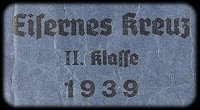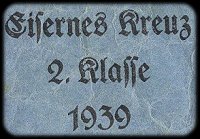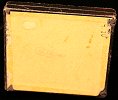
by Sebastián J. Bianchi
The cases of the Iron Cross varied depending on its class and status; those pieces intended for retail sale generally had a much more ornate presentation than those crosses which were to officially be awarded by the Wehrmacht. Thus, the first home of a freshly manufactured cross ranged from a simple paper envelope to a decorated presentation box.
There is evidence that indicates that cases and envelopes were subcontracted and thus, many manufacturers share characteristics.

Sebastián Bianchi collection
Iron Cross 2nd Class
The Iron Cross 2nd Class was generally housed in two ways - in an envelope, or in a black leatherette case.
Envelopes
Regulation Iron Cross 2nd Class was presented in envelopes that could be either light brown or blue. On the obverse the grade of the cross was printed in three lines "Eisernes Kreuz - 2, Klasse - 1939", and on the reverse the manufacturer was commonly imprinted (though as mentioned envelopes were likely manufactured by a subcontractor). When untouched, the cross would come wrapped in tissue paper.
Besides the above representative examples, the manufacturers below have pictures of Iron Crosses with envelopes.
| 1 | Deschler & Sohn | München |
| 3 | Wilhelm Deumer | Lüdenscheld |
| 11 | Grossmann & Co. | Wien |
| 12 | Frank & Reif | Stuttgart-Zuffenhausen |
| 15 | Friedrich Orth | Wien |
| 21 | Gebr. Godet & Co. | Berlin |
| 24 | Arbeitsgemeinschaft der Hanauer | Hanau am Main |
| 25 | Arbeitsgemeinschaft der Graveur-Gold-und Silverschmeide-Innungen | Hanau am Main |
| 44 | Jakob Bengel | Idar/Oberdonau |
| 49 | Josef Feix Söhne | Gablonz a.d.N. |
| 56 | Robert Hauschild | Pforzheim |
| 65 | Klein & Quenzer A.G. | Idar Oberstein |
| 93 | Richard Simm & Söhne | Gablonz a.d.N. |
| 98 | Rudolf Souval | Wien |
| 106 | Brüder Schneider A.G. | Wien |
| 109 | Walter & Hentein | Gablonz |
A sampling of different lettering used on envelopes.
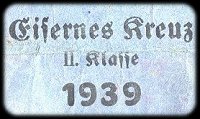 |
 |
|
|
|
Determining the authenticity of envelopes in the face of the fake onslaught is a challenge for every collector. This is particularly so because of the great variation in them. The black light test can be used as a tool, but a keen eye for detail is also a necessity. An original envelope should have a coarse, raspy look to it, and should show its age.
Cases
Cases of the Iron Cross 2nd Class also come in a variety of flavors. One often encountered is the "standard" LDO box. These are black leatherette boxes with the LDO logo imprinted on to the top lid and a felt tan base where the Iron Cross rests comfortably in a outlined depression. The bottom can be stamped with the manufacturer name.
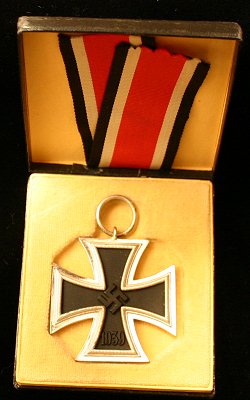
Sebastián Bianchi collection
Click on images to enlarge
The other cases of the 2nd class vary greatly. One may encounter cases with the Iron Cross motif on the lid, some without, with ribbons and even some with room for a ribbon bar. Since these are so eclectic, determining authenticity is a challenge that must be undertaken on an individual basis.
Iron Cross 2nd Class Ribbon Envelope
Below is an example of the rare Iron Cross ribbon envelope.
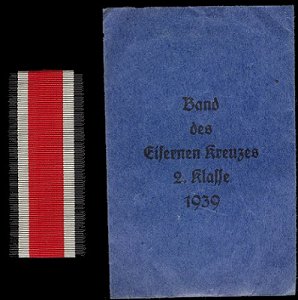
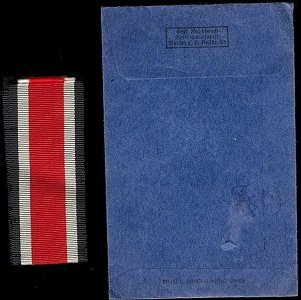


Alan Pilch Collection
Clasp to the Iron Cross 2nd Class
The clasp that was attached to the ribbon of the 1914 Iron Cross came packaged in two ways - an envelope, and a small LDO box. A third option, an elaborate double/Spange presentation box, was also used for high ranking recipients.
The envelope was in the same theme as the Iron Cross 2nd Class, having the name of the award in the front and the manufacturer's name in the back. It is a rather rare envelope.
 |
 |
A Deumer marked envelope. The clasp that
came with the envelope can not be verified as Deumer.
Sebastián Bianchi collection |
Another variation of Wilhelm Deumer. Tim Ball Collection |
LDO boxes used were light blue or brown in color. They consisted of a topless box with a felt bottom that had a slide-on cover featuring the LDO emblem on the front and the maker's mark in the back. The box slid in and out like a drawer. A piece of Iron Cross 2nd Class 1914 was included at the bottom of the box as pictured below.


Sebastián Bianchi collection
Iron Cross 1st Class Cases
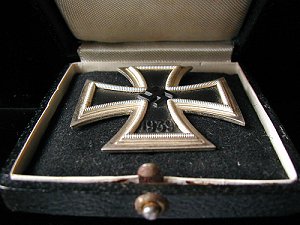
The Iron Cross 1st class also came housed in an more luxurious manner - a black leatherette box with an Iron Cross motif on the upper lid. Hinged on one side and operated with a push-button pin, the inside of the lid was covered with a white satin finish and the bottom with a black, tan or white felt material. This bottom had a slit in which the pin of the cross rested.
 |
A Deumer Iron Cross inside its box. More pictures in the Iron Cross 1st Class Section Sebastián Bianchi collection |
|
Within the general description above there is a great deal of variation. The top part of the lid could be domed or flat, and the Iron Cross motif could have wide lines, small lines, be filled it, or not be present at all.
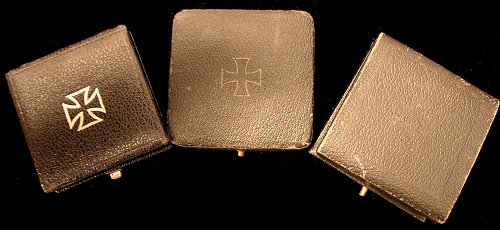
Different cases of the Cross
Sebastián Bianchi collection
But even with these variations there are signatures that distinguish a World War II era box from a currently manufactured one. With a little effort, the bottom of most cases comes out and reveals vital clues. One very important indication and a point to be carefully examined is the glue, which should be animal glue (an adhesive made from animal hide, primarily cattle). This has a different look from modern glues, which are synthetic in nature. There are other clues, for example, cases are often encountered with a penciled number inside and the manufacturer's code (the maker of the case, not the cross). A manufacturer mark regularly found is D&B surrounded by an oval. Numbers are also found inside the cases, for example several identical cases in the author's collection have the numbers 2597 on the back of the base and the number 2420 on the base itself.
Some degree of caution should always be exercised when a cross comes inside a box, because collectors can "marry" one and the other fairly easily.

A Klein und Quenzer cross, and the inside of a box
Sebastián Bianchi collection
In the pictures above (click on them to
expand) you can clearly see what the animal glue should look like, as
well as the circled D&B, raised numbers, and pencil mark present
in the majority of Iron Cross cases.
Marcus Hatton Collection |
|
The Iron Cross when shipped from the factory came with an outer cardboard box, which was supposed to be given to the recipient. In reality the box was often opened and discarded, making the outer protection of the case one of the most rare items in the realm of Iron Cross cases.
The cardboard box had the name of the award (Eiserner Kreus 1. Klasse 1939) and the legend "Only to be opened by Recipient". On the side, the name of the maker was printed.

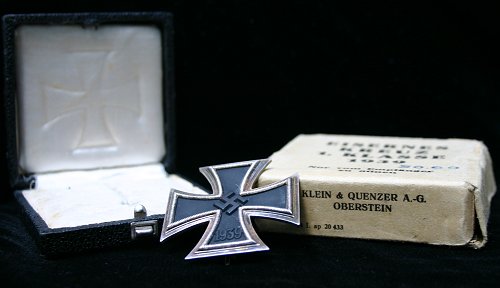
Sebastián Bianchi collection
 |
|
| A C.F. Zimmermann Box | A peculiar Paul Meybauer box with a 1940 date. The box looks otherwise original...a print error? |
 |
|
| Rudolf Wachtler & Lange | A Carl Wild Box. |
 |
|
| A Wilhelm Deumer Box | A C.E. Juncker box |
Spange to the Iron Cross 1st Class 1914
The Spange to the Iron Cross also came in a leatherette case with the award embossed on the top, or in an envelope. The case and envelope shared many of the characteristics of the Iron Cross cases above.
© Copyright Wehrmacht-Awards.com LLC |




